Fix Your Swing - The PGA Tour Way
October 2010
- by Kelvin Miyahira
This is the tale of two great PGA tour players being taught by two well known golf instructors at the 2010 PGA Championships at Whistling Straits. Since the television cameras aren’t shooting at the range during major championship events on practice round days, you aren’t likely to witness how PGA tour golfers are really taught when it’s crunch time. Lucky for me, I’ve seen some interesting methods that you can learn from.
The PGA stars in this story are Padraig Harrington and Paul Casey. While they are tremendous players, it does not mean they have perfect swings. In fact, Padraig has been revamping his swing for two years now and is still struggling to regain the form that won him three major championships and Paul has been struggling with this motion his whole career.
They are both suffering from a lack of lateral bend, however they are compensating for that missing move in two different ways (which will be covered later in the article). The most interesting thing is how the top instructors deal with their student’s problems (which are really the compensation moves). You might learn something from them. So let’s get to it.
The first player is Padraig Harrington with instructor Dave Phillips of the Titleist Fitness Academy show on The Golf Channel. Here’s Dave in the red shirt vigilantly watching Padraig’s swing plane.

Little does he know that Padraig suffers from a lack of lateral bend and this has him choosing to drop his club behind him during the downswing in a compensatory way. This is causing the club to be a little too flat and below the plane.
So what does the co-host of TPI’s golf fitness show Dave Phillips do? He does what any planeologist would do. He forces the club back in front and on plane. In addition, he invents a great way to ensure that happens.
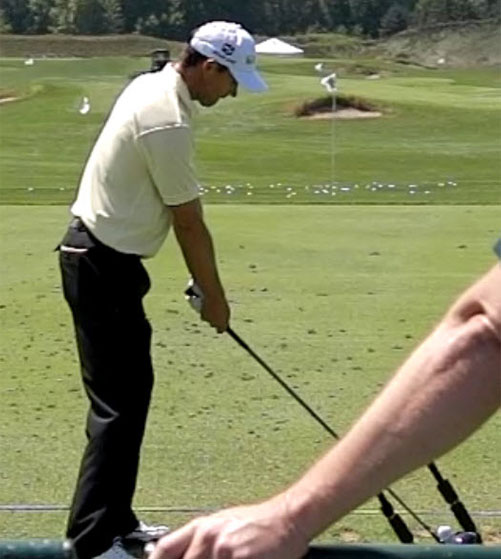
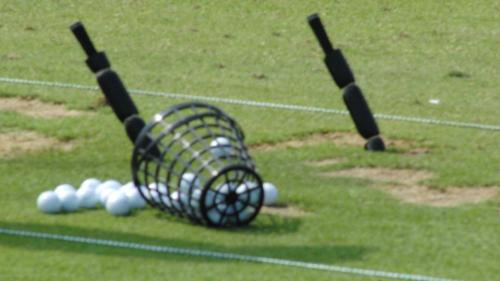
Note: Space to swing between the two sticks is larger than it appears due to the camera angle. See earlier photo for a better idea of how narrow the opening is.
This should be called the “Outside Approach” in contrast to the once popular Jack Nicklaus peddled contraption called the “Inside Approach”- which supposedly stopped people from coming over the top. These are two sticks made from two shafts that were cut off near the grip and covered with foam insulation for protection in case they are accidentally struck. The inside stick was placed just before the ball and where a club approaching from too far inside would actually be struck. The outside stick was placed just ahead of the ball and where the club would strike if it went too far outside the line. In essence, it works opposite of the Inside Approach. The Outside Approach ensures that your club will approach from outside the target line and swing a little to the left of target.
Watch Padraig’s motion and compare to Tiger’s below.
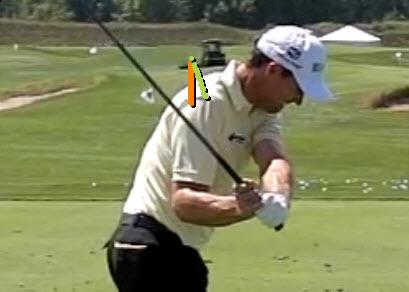
The orange line is the path of the right shoulder if lateral bend has occurred. We would also see a concave curve of his back from this angle whereas we are seeing him with a more rounded, convex or turtle back. Paddy is following the dotted green line which shows a rotation of the body around a stiff spine and lack of lateral bending.
See if you can sense the slight disconnect of the arms that is needed to flatten one’s plane when true lateral bend is not there.

Paddy has his right shoulder farther forward than Tiger ’08 at this point. This means he’s not lateral bending and is rotating his shoulders instead. Look at the where the placket on Tiger’s vs Paddy’s shirt is pointing. Tiger’s is facing far more away from the target vs. Paddy’s is close to facing the ball already.
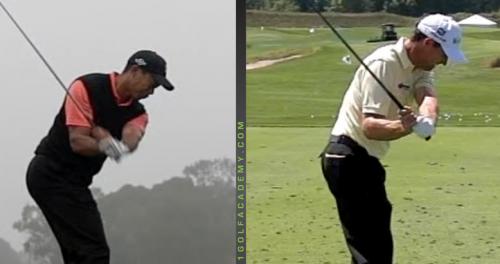
At this point you can see that Paddy’s shaft is flatter. But how does he do this if he’s not lateral bending?

This picture shows how he’s doing this. It is simply by rotating his left arm so that his shaft plane flattens. However, his hands are farther forward and his shoulders have rotated too early. See how Tiger’s hands are inside his chin line and his shoulders have not fired yet whereas Paddy has his hands outside the chin line. This means Paddy would actually be coming over the top if he didn’t make the fake club drop and can only swipe at the ball using his hands because his arms aren’t in the proper position to deliver the club.
Thus, his club would naturally approach the ball from too far under the plane right? But since this isn’t a good way to strike it, maybe if you just shove the club back in front of you by using the Outside Approach??? Hmmmm, sounds like a great idea!
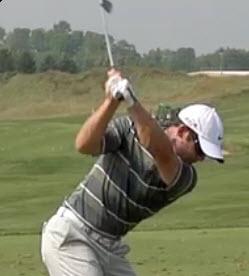
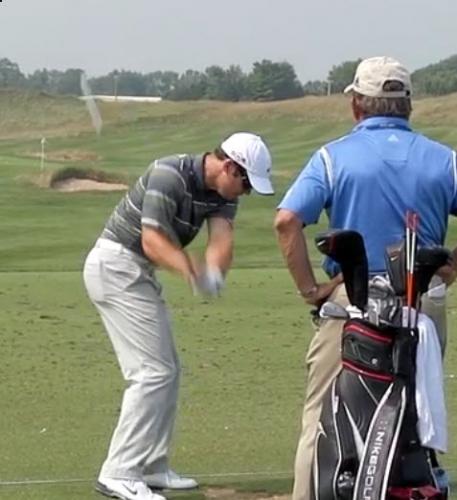
The Outside Approach training aid really works! It has Paddy bringing the club in straighter to the target line and hitting 20-yard fades with it.
Paul Casey
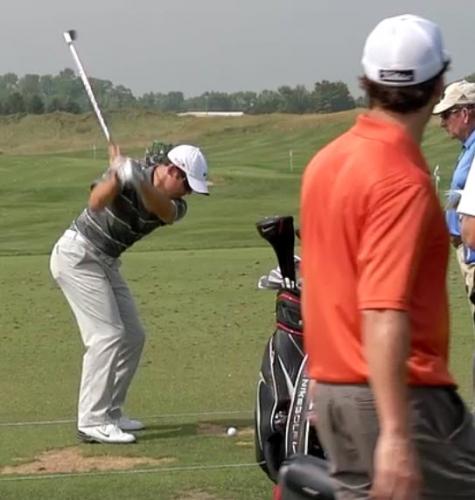
Under the watchful eye of Peter Kostis (light blue shirt), Paul Casey still looks a bit steep on his downswing and his shots are a bit fadey. So he instructs Paul to close his stance and hit hooks.
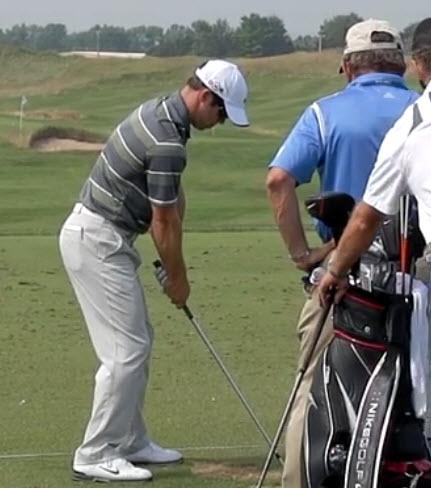
So here’s Paul closing his stance and it was amusing to see him hitting big 15-yard hooks with a 5-iron. I’m sure that’ll come in handy someday when he’s in trouble and needs to hook it around the trees.
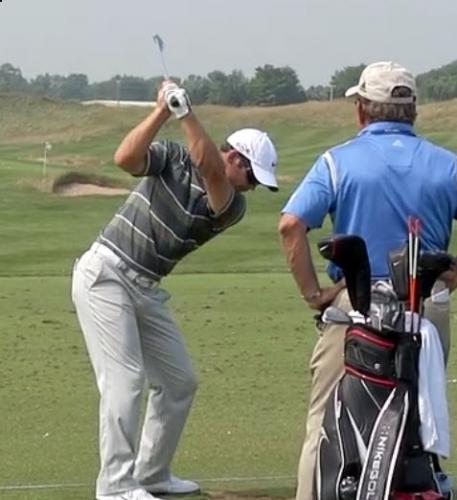
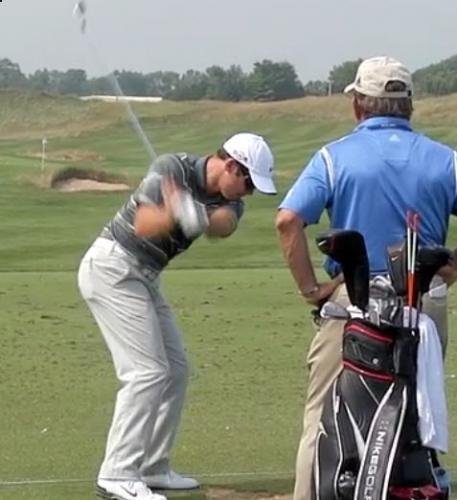

Thus, his stance has changed, his ball flight changed, but his swing still remained steep at the start of the downswing. What is changing is his club’s approach to the ball.
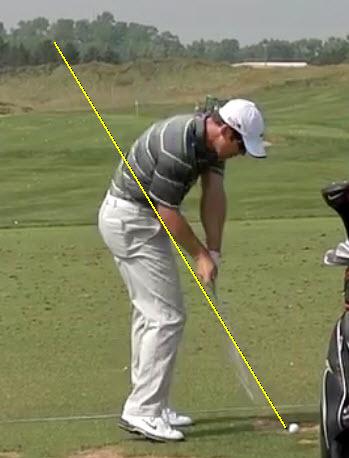
He’s getting the club to go slightly under the plane (the same malady that Paddy is fighting to change) in order to hook the ball.
In one sense, this is perfectly understandable. You wouldn’t want to fiddle too much with a great player’s swing on the week of a major championship. On the other hand, this does not get to the root of the problem thus the symptoms will never really go away. I can just imagine Paul getting a bit frustrated at this and finding a new teacher who will then say, it’s too far under the plane so let’s use the Outside Approach to get it back on track. Does anyone see the vicious circle he’d be in?
That’s how they are taught on the PGA tour. What saves these two players is there excellent hand-eye coordination and great release moves. Padraig is a slight underflipper while Paul is a bowed DH’er. Their ability to get the clubface square trumps all these other errors and allows them to succeed at the highest levels on the tour. Thus, the lesson to be learned is, if you don’t have all the best moves, you should at least try to learn how use your hands correctly to square that clubface consistently.
Oh, and one more thing. Don’t go out and buy the Outside Approach.

